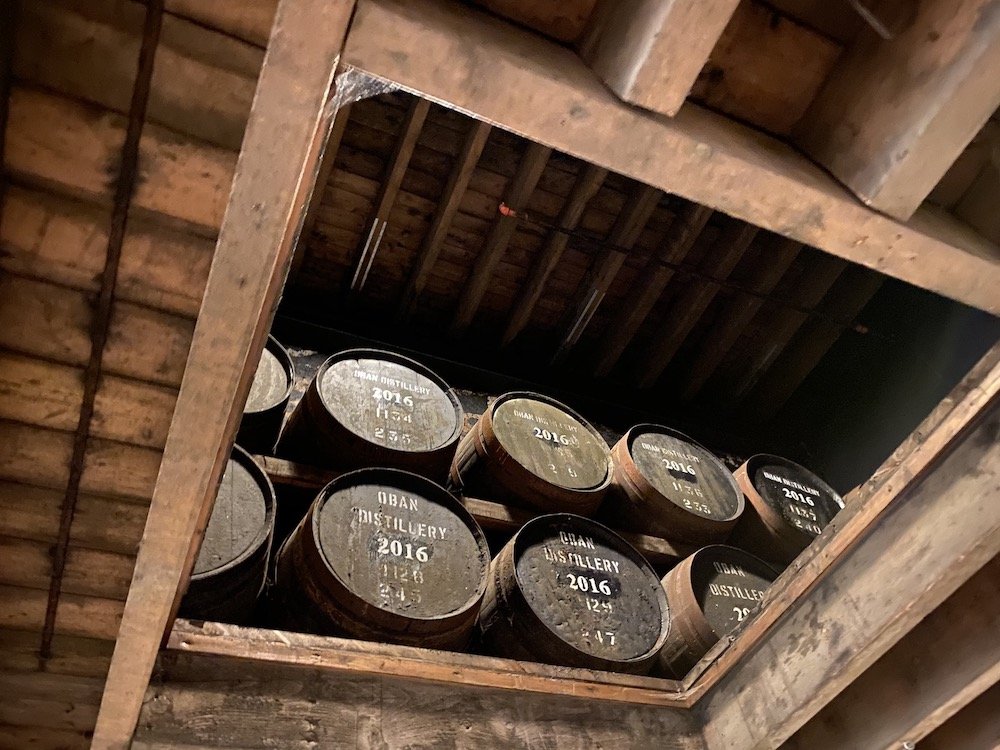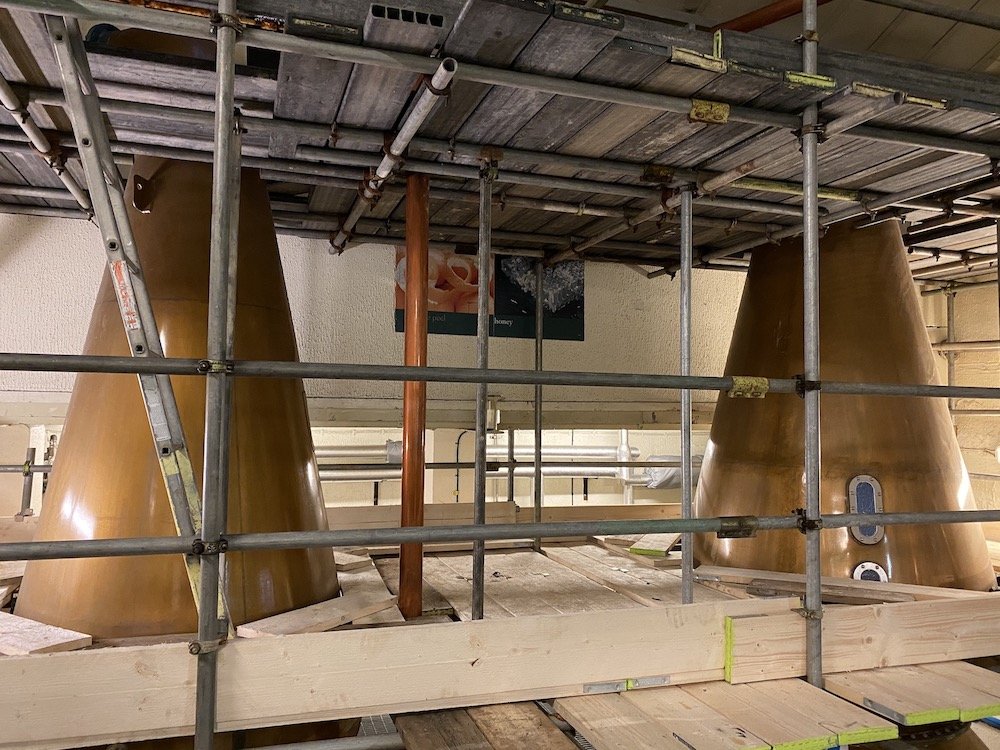Beerlandia: Touring Oban Distillery
There's a reason why "like a kid in a candy shop" is such a commonly used simile - that shit was awesome. It's also a fairly relatable experience. So, as a lover of whisky and bourbon, I hope you can feel what I felt when I walked into the barrel room of Oban Distillery in Scotland. This was as close as I'd ever been to a personal Willy Wonka moment, without the questionable safety practices and the Oompa Loompas to hide the bodies.
After walking a good 10 miles around Oban on my first day out of quarantine, I felt that the only logical conclusion to such a great travel day was a guided tour of the place that put Oban on the map. The distillery sits at the center of the high street by the harbor front. Its single burnt-orange smoke stack points upward to McCaig's Tower resting on Battery Hill like a crown. The closer you get, the more pungent the smell of malted barely becomes.
The combination of the off-season and Covid meant that we essentially had a private tour. Gordon, our guide, was knowledgeable and kind, and the tour felt more like an informative but casual hangout with a friend showing us all the cool shit in his house. Covid guidelines were still in place at the time, which meant we could not actually consume any alcohol on the premises. Oban Distillery made up for this big time by providing small glass bottles with about 35ml of Oban 14 (with an Oban glass!) at the beginning of the tour along with other treats that popped up along the way.
We're just making bad beer.
After crossing the threshold between the shop and where the sausage is made, we found ourselves in a large room aromatic with malt and containing several large copper vats. I can recognize that I'm in a distillery; I can't begin to describe what all the doodads and doohickies do. That's what Gordon is for. As he put it, "We're just making bad beer".
“Gordon uncorked one of the casks and loaded up a couple of sampler bottles with this fiery young spirit. I felt my nose hairs curl even from an arm's length away.”
The beginning of the distilling process really isn't that different. The main ingredients - water, yeast, and barely - are exactly the same with the exception of hops. Water is added to the barely and it is laid out to germinate. Next, it's kilned, or heated up to produce those familiar aromas, flavors, and colors of roasted barley. It's no wonder that a distillery and a brewery smell essentially the same. The barley is ground and added with hot water to containers called tuns. Once this mixture sits for a while and the barley releases sugar, a brewer would add hops before adding yeast. Distillers skip the hops and add yeast immediately. After fermentation, this mixture is called the wash.
Here, the similarities between brewing and distilling end. In the first distillation, the wash is heated in copper pot stills to evaporate, condense, and ultimately separate from the solids. The second distillation separates off other compounds that are later reused in the next batch. Once the spirit finally makes it into a barrel, it's clear in color and powerful enough to fuel a billionaire's rocket at 68% ABV. Gordon uncorked one of the casks and loaded up a couple of sampler bottles with this fiery young spirit. I felt my nose hairs curl even from an arm's length away.
Nearly all the casks used for maturation are former white oak bourbon casks from the States, which sounds deeply poetic but the historical reality is rooted in practicality. After Prohibition ended in America, the powerful Cooper's Union (barrel makers) successfully lobbied for a law that mandated bourbon casks could only be used once. This kept the coopers in business and provided a cheap supply of gently used casks that Scottish distillers were happy to take advantage of. Red oak sherry casks from Spain are a common alternative that produces very different colors and flavors.
To peat or not to peat?
It's a regional question.
Some people love a little smoky bacon and iodine seaweed with their Scotch - many hate it. Whatever your preferred poison, you can thank the sheer isolation of the Hebrides whenever you encounter the unmistakable hints of peat filling the room after popping a cork. The isles lacked the abundance of timber that was normally used to roast the barley further inland, so distillers did what any hardy folk out in the sticks do: improvise.
At some point in the 18th Century, someone held up a match to some peat and discovered it had a lot of the same properties as coal. This new reliable fuel source helped the isles and some parts of the Highlands stay competitive in the whisky game while adding their unique flavor profile to the market. The peat smoke's influence on the barley produced something completely different from the traditional honey, vanilla, and pear notes of the distilleries with easy access to wood.
Let's stop learning and drink some whisky.
Oban 14 (43% ABV)
So where does Oban sit? Its flagship offering is a 14-year that captures a medley of notes from the Highlands and the Hebrides. Light amber in color, this dram smells of light toffee and vanilla. The distillery's tasting notes single out honey, orange peel, and sea salt with a lightly smoky finish. I won't pretend to be anything other than an average guy with an average plate - I can only speak for the honey, a bit of pear, and the slight touch of peat at the end. Oban does use lightly peated barley, which adds to its smooth complexity rather than completely overwhelming your senses as some Islay whiskies do. Oban 14 is an absolute pleasure every time I have it.
Oban 9 from Cask (68% ABV)
“If you take your time, you can identify slight pear notes with a bit of toffee and sea salt - the developing profile of Oban 14.”
This little treat was taken 5 years premature from former Bourbon casks of white oak. Nearly clear with a slight amber tinge, it almost looks like a Chardonnay. The piercing aroma of ethanol lets you know that you're mistaken. At 68%, it's hard to look past the potency.
If you take your time, you can identify slight pear notes with a bit of toffee and sea salt - the developing profile of Oban 14. Even with small sips, you will feel the fumes coat your mouth immediately. I may have even coughed once or twice. While probably not the best of the bunch, this is something unique you're only going to taste inside the distillery.
Oban Distiller's Edition (43% ABV)
As if the two samples of Oban 14, the 9-year tickle from the cask, and the Oban whisky glass weren't enough swag to satisfy any whisky-lover, the distillery also threw in a sample of their premium Oban Distiller's Edition. Matured for the second time in sherry casks, this whisky has inherited a deeper golden color from the darker wood. Decadent butterscotch flavors are at the forefront with a more pronounced smoky finish to add some grit to one of the smoothest whiskies I've ever had. It was a pleasure to try this without shelling out the cash for a full bottle.
It's nice to have a break from baijiu.
The Beerlandia mission is to grasp cultural threads present in a country's alcohol and follow them to a deeper understanding of the culture. I know, I know, it looks like an excuse to get drunk, but I promise that it will open some doors that would otherwise remain closed. Let me tell you, not every national drink is a winner. After several years of enduring Chinese baijiu at the ends of old uncles at wedding parties challenging me to a last-man-standing drink to the death, it was nice to savor some world-class scotch. If you're ever in Scotland, visit Oban Distillery and add that extra layer of understanding and appreciation to your next dram. ◉
Written by Seth Barham














